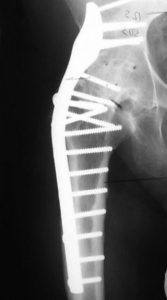Last Updated on October 29, 2023
Hip arthrodesis is a procedure where hip joint is surgically fused. It is used for management of advanced hip arthritis in a selected group of patients. A common procedure earlier, its utility has decreased with the success of total hip replacement surgery.

The procedure aims to provide stable, painless hip at the cost of hip movements. Because hip movements are not thereafter hip arthrodesis, the gait of the person becomes less efficient and uses more energy.
There is increased pelvic rotation of the contralateral hip and increased stress at adjacent joints. This could lead joint degeneration of the lumbar spine, ipsilateral knee or contralateral hip may be affected leading to symptoms in these joints after about two decades of surgery.
The surgery is classically performed in young patients with a desire to return to near-normal physical activity which includes heavy labor work
Prerequisite for Hip Arthrodesis
- Normal contralateral hip
- Normal ipsilateral knee
- Normal low back are prerequisites in preoperative planning
- No cardiovascular pathology [hip fusion raises oxygen consumption by 30%]
Indications of Hip Arthrodesis
- salvage for failed total hip arthroplasty [most common indication in modern orthopedics
- Young active laborers with painful stiff hip after infection or trauma
- Neuropathic joint
- Tumor resection
Contraindications to Hip Arthrodesis
- Active infection
- Limb-length discrepancy > 2.0 cm. [if required, may be corrected]
- Bilateral Painful Hip arthritis
- Degenerative changes in
- Lumbar spine
- Contralateral hip
- Ipsilateral knee
- Severe osteoporosis
- contralateral total hip arthroplasty [increases the failure rate of existing total hip arthroplsty]
Position of Hip Arthrodesis
- 0-5 degrees of adduction
- External rotation of 0-30 deg
- 20-25 deg of flexion
Avoid abduction as it creates pelvic obliquity and increased back pain.
The position is designed to minimize excessive lumbar spine motion and opposite knee motion which helps minimize pain in these regions.
This is because pain and instability of the ipsilateral knee may result after hip arthrodesis and the patients with a fused hip may also develop radicular knee pain.
Surgical Procedure
Goals of surgery are to achieve good apposition of surfaces, rigid fixation so that early mobilization can be promoted.
Procedure
The hip may be approached by anterior-posterior or lateral approach. It is important to preserve the abductors and avoid injury to the superior gluteal nerve
Plating and screws are commonly used implants. AO cobra plate is preferred plate. Trans-articular sliding hip screw lag screw can also be used but may require postoperative hip spica casting.
Some authors advocate supra-acetabular osteotomy or subtrochanteric osteotomy for improved positioning.
Complications of Hip Arthrodesis
- Malposition – This most common complication
- Nonunion
- Leg length discrepancy (Some may require shoe lift)
- Degenerative joint disease
- Instability of ipsilateral knee, back, and contralateral hip
- Low back pain [> 50% of patients]
Conversion of Hip Arthrodesis to Total Hip Arthroplasty
Sometimes, the patient may develop problems with hip arthrodesis and need to convert that into total hip arthroplasty
This may be required in
- Severely back pain (most common)
- Severe ipsilateral knee pain with instability
- Severe contralateral hip pain
Clinical outcome is dependent on abductor complex function
Such conversions may require intensive and prolonged rehabilitation.